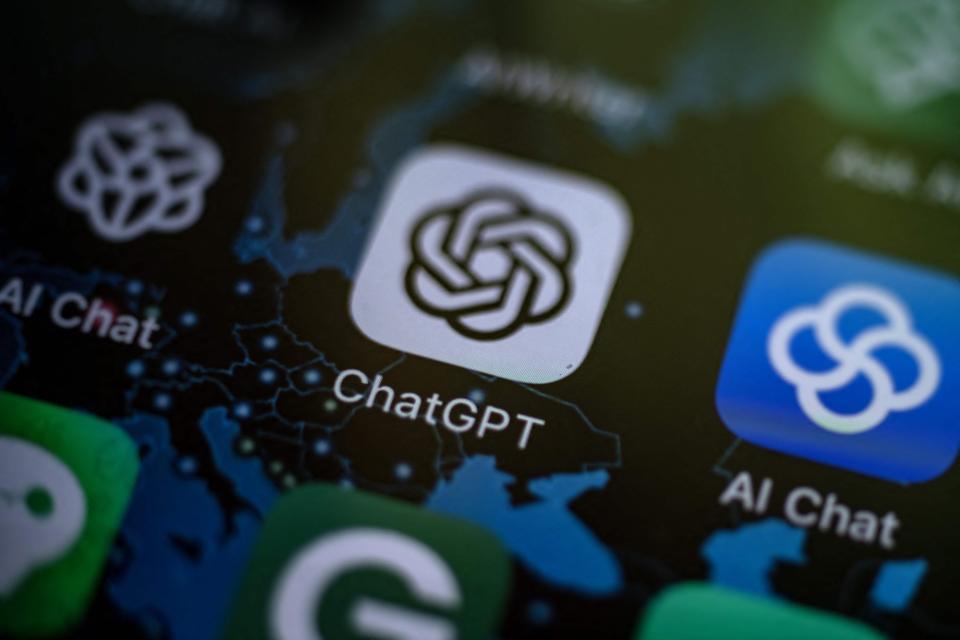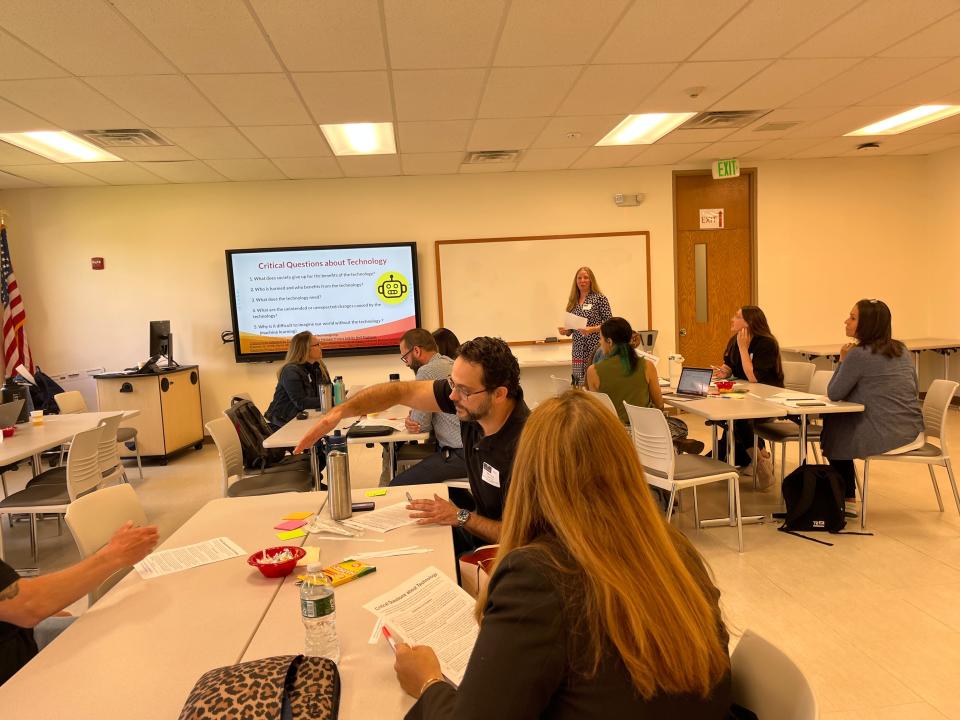How schools are trying to find balance between ChatGPT, keeping student information secure
Teachers and school administrators in the Lower Hudson Valley are brainstorming how they can use ChatGPT to plan lessons and classroom activities. But as the new school year begins, questions remain about how exactly schools can use the much-hyped artificial intelligence language model and who can use it.
On the one hand, district and school leaders say they want to teach students how to use ChatGPT responsibly. But on the other, state privacy laws may mean students may not be able to use it directly — at least not while at school.
"We need to recognize that there are potential threats with it, but it is here," said Clarkstown Superintendent Marc Baiocco, president-elect of the Lower Hudson Council of School Superintendents. During an orientation with new staff members, Baiocco said he encouraged teachers "to look at ways that we can use it usefully in the classroom and embrace it."

In New York, section 2-D under state Education Law outlines requirements for protecting the personally identifiable information of students. It requires software companies to sign school districts' Parents' Bill of Rights, which every district is required to publish on its website, letting parents know the legal requirements for protecting students' information.
For software to be used by students, software companies have to either sign individual districts' Parents' Bills of Rights or one that covers all districts, said Jennifer Cronk, an instructional technology leader who has worked for several Lower Hudson school districts and organized regional technology events for educators.
As far as school and district leaders can tell, the company that created ChatGPT, San Francisco-based OpenAI, has not signed any Parents' Bills of Rights in New York.
"Our Parents' Bill of Rights protect student data, so we can't allow students to have access to ChatGPT without having this piece signed," Cronk said.
State says use of ChatGPT is local decision
As of now, it's up to school districts to decide if and how they will use ChatGPT.
The state Department of Education, asked whether use of ChatGPT is compliant with section 2-D, said only that school districts must be generally mindful of privacy laws.
"When selecting and utilizing digital tools, districts and schools should be mindful of privacy and security laws and regulations," officials said in an emailed statement, noting section 2-D of Education Law and part 121 of the Education Commissioner’s Regulations, which also address data privacy and security.
Education Department officials said instructional decisions about tools, curriculum and programs are up to districts.
Cathy Woodruff, a spokesperson for the New York State School Boards Association, said the organization was referring questions about what would violate student privacy laws to the state Education Department.
Finding balance between using technology while protecting security is the 'conundrum we're faced with'
Technology experts continue to wrestle with compliance questions.
ChatGPT requires the user to log in to use it, which makes it subject to section 2-D's requirements for protecting student information, said Jennifer Harriton-Wilson, Putnam-Northern Westchester BOCES' education technology coordinator.

Other AI programs that don't require a login, such as Scribble Diffusion, a program that turns doodles into realistic looking images, are fine to use as they don't collect student information, she said.
But there may be wiggle room for districts when deciding how to let teachers use ChatGPT.
Baiocco said teachers could use ChatGPT without violating 2-D as long they do not put student information in it or have students log in at school. Depending on the assignment, he could see scenarios where teachers ask students to use ChatGPT at home, where 2-D would not apply.
Cronk disagrees: "If the kids cannot use it in school, a teacher certainly has no business saying 'use this at home'."
Baiocco said trying to balance the use of new technologies while protecting student information is "the conundrum that we're faced with."
Wilson offered some advice: teachers should make sure they don't put student names or information into ChatGPT and make sure their district is OK with them using it.
Learning how to apply AI for schools
ChatGPT has been a major focus for educators across the country since its rapid rise to prominence after its release in November. As school districts across the country grappled with how to handle ChatGPT, some went as far as blocking access to it at school.
In the Lower Hudson Valley, many educators say they've accepted that ChatGPT is here to stay, and they'd rather prepare their students to use it.
Fred Ende, director of curriculum and instructional services for PNW BOCES, said BOCES' work around AI began in full force last winter when districts started asking about ChatGPT and how they could potentially use it. PNW BOCES now plans on a series of sessions for educators focused on ChatGPT and artificial intelligence in general, how it could be incorporated in education and the ethics behind using it.
The series, made up of four meetings this year, will include exploring "what homework can be, knowing that these tools are out there," Ende said. If teachers know ChatGPT can write an essay, "how do you rethink the idea of essay writing so that students can benefit from a tool like ChatGPT?"
Educators are also thinking of how ChatGPT could save them time in lesson planning and in other work. Ende heard from an English teacher who had ChatGPT write 10 haikus about famous literary characters and planned on having students try to identify who each haiku was about.
Ende heard from an administrator who talked about using ChatGPT to help analyze results from a survey given to teachers about what they want to accomplish in the next school year.
"There may have been a significant amount of fear and worry in the last year, and it's been just awesome to see that conversation transitioning to like, 'OK... it's new. Yeah, it's different. There's a lot we don't know, and how do we connect it to some of the work that's going to be most compelling for students?' " Ende said.
In the future, it's possible that classes will be available to middle or high school students on how to ask chatbots questions and use them to their fullest potential, Ende said.
Future teachers are also already learning about AI. At Manhattanville College, President Frank Sánchez said that teachers in training will need to have AI literacy to be competitive applicants for jobs.
Many questions yet to be answered about ChatGPT use by schools
For months, the conversation around ChatGPT has revolved around how it — and other forms of artificial intelligence — will transform life and work as we know it. A state report released last month reported that schools have hardly used AI, so far, to identity or track students with handprints, retina/iris patterns, DNA sequencing, or voice or gait recognition. But the report indicated interest among some districts in using facial recognition technology in the future.
Lower Hudson educators agreed there are plenty of unknowns around ChatGPT and how it will be used, but remained open to its use in the classroom and by teachers.
Some educators mentioned ethical concerns, such as the possibility of ChatGPT being biased against certain groups.
There are also concerns over ChatGPT being used to cheat, but several educators described similar concerns every time a new technology comes out. Orande Daring, interim principal of Valhalla Middle School, said one of the biggest challenges in using it will be determining how much student work is from ChatGPT.
There are programs and strategies to address cheating, such as AI-detecting software and more in-class writing activities.
Educators will have to find the right balance for using AI. They'll want to streamline their work and prepare students for the future workplace, but not make it easy for students to get around learning fundamental skills.
The chatbot, for instance, can quickly write an essay or speech with a few simple directions from a human. Educators say there may be a place for students to use ChatGPT to get started on essays or learn to structure a speech, but that students would have to put in the work of adapting ChatGPT's results to what they need.
The goal is to use AI to advance students' thinking and schoolwork, not to replace it.
"We do want students to develop critical thinking skills, problem solving skills, things like that," Daring said. "And yes, you can do it using chat GBT, but it's different. You're telling the computer what you want it to do."
Contact Diana Dombrowski at ddombrowski@gannett.com. Follow her on Twitter at @domdomdiana.
This article originally appeared on Rockland/Westchester Journal News: ChatGPT in NY schools: Educators balancing privacy laws, teaching tech

